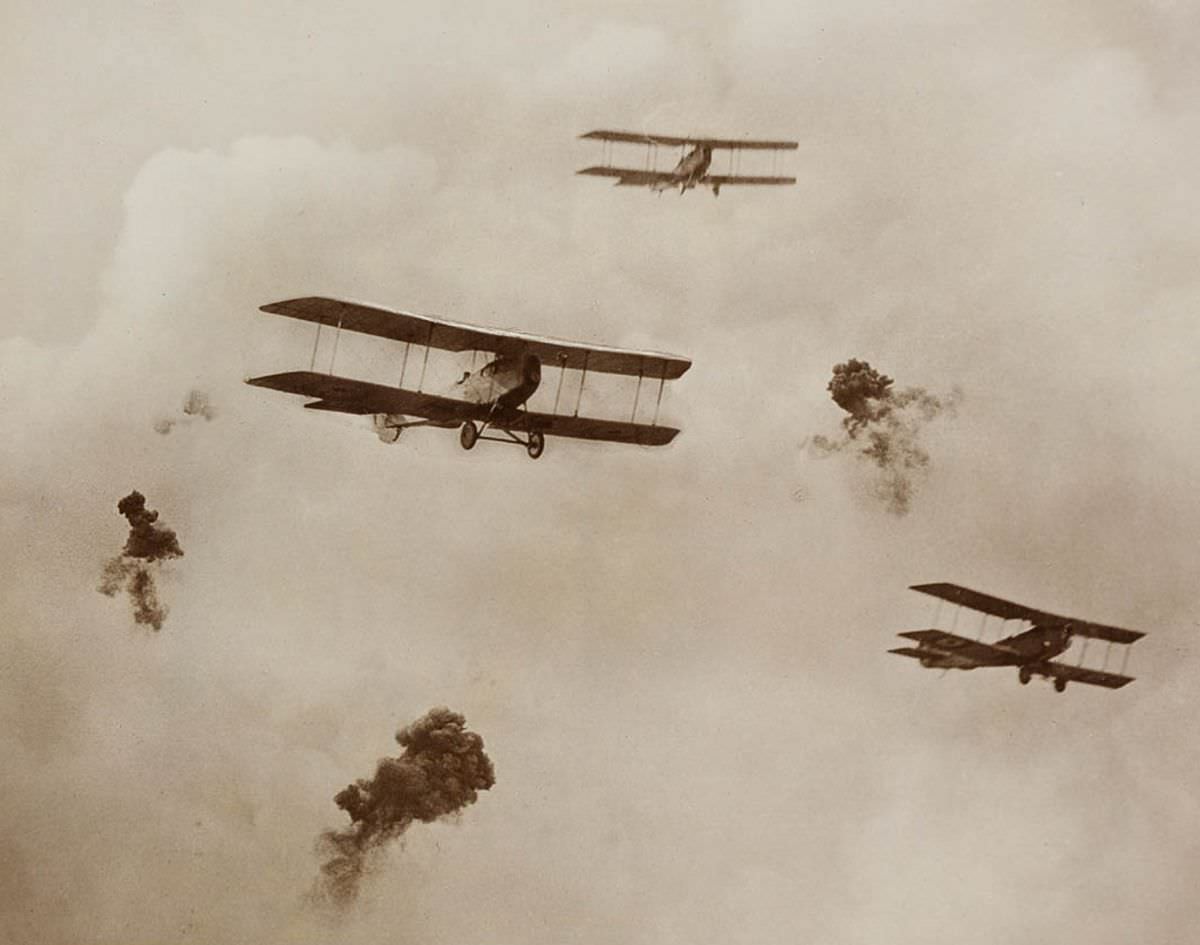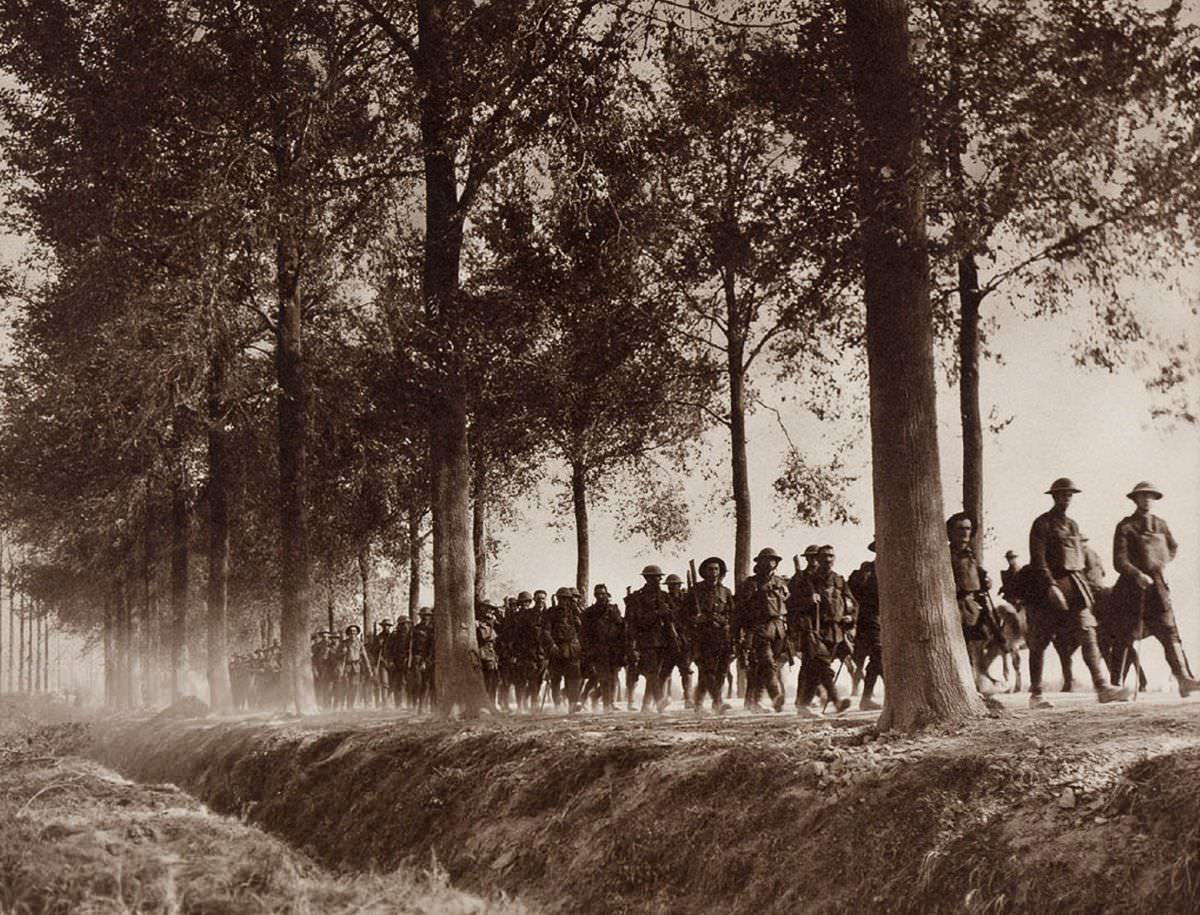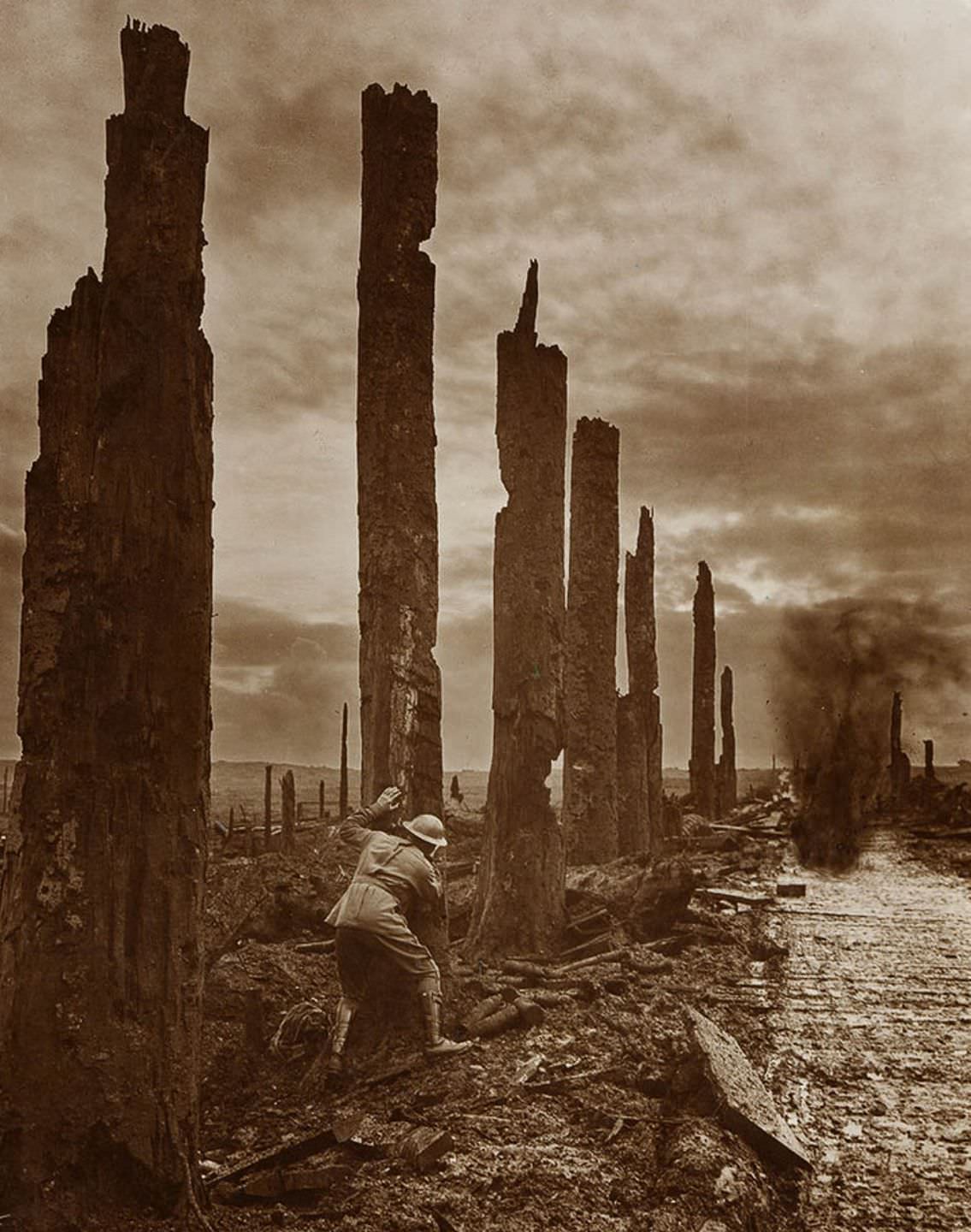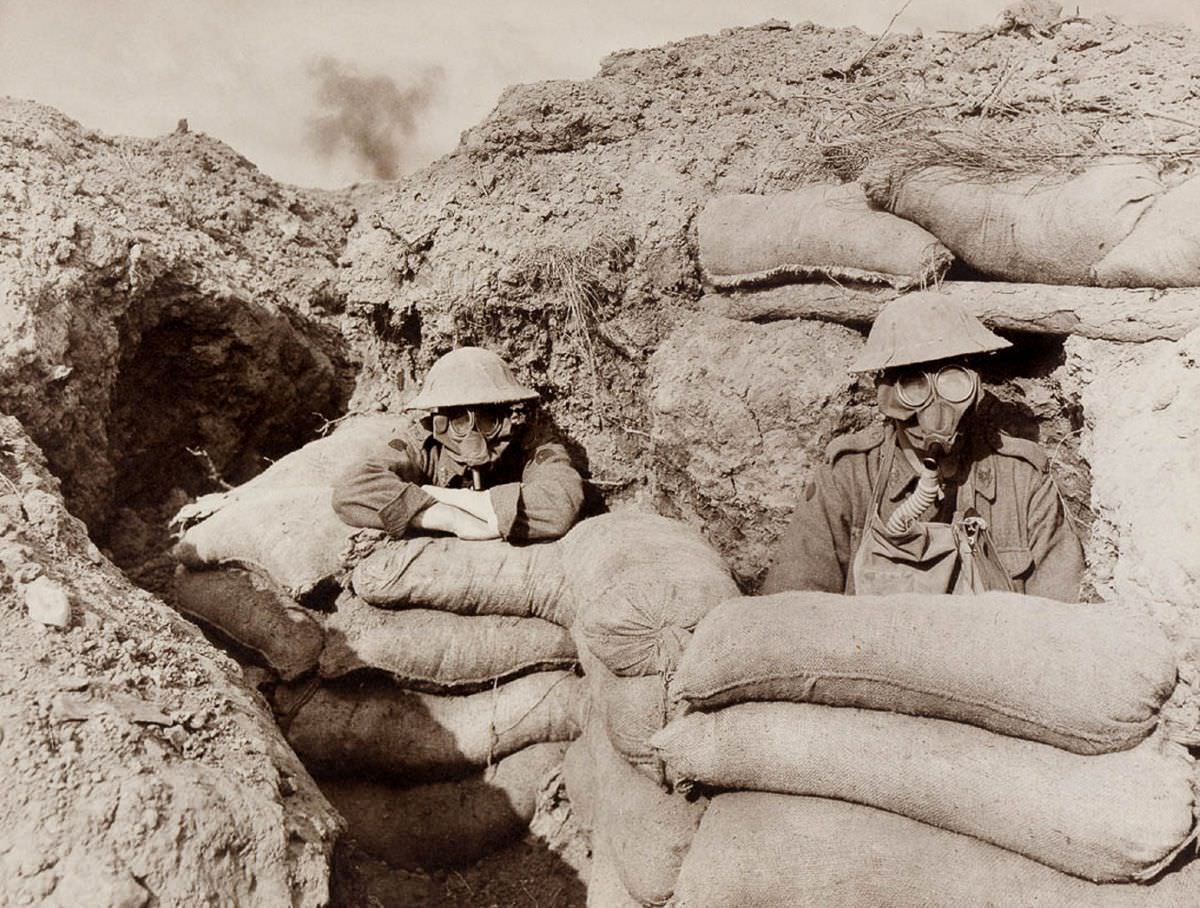Frank Hurley was an Australian photographer and filmmaker best known for his photographs of the Western Front during World War I. He was appointed as the official photographer for the Australian Imperial Force (AIF) in 1917 and was sent to the Western Front to document the experiences of the Australian soldiers there.
Hurley’s photographs of the Western Front were taken during some of the war’s most intense and bloody battles, including the Battle of Passchendaele. He was known for his ability to capture the raw emotion and humanity of the soldiers in his photographs and the brutal realities of trench warfare. His photographs depicted not only the soldiers but also the landscapes, the trenches, and the daily life of soldiers at the Front.
Hurley’s photographs are considered some of the most iconic and powerful images of World War I. They provide a unique and powerful record of the experiences of the Australian soldiers on the Western Front, and they have become an important part of Australia’s national memory of the war.
#1
#2
#3
#4 An episode after the Battle of Zonnebeke.
#5 21st August, 1917

The day has at last arrived & I have left London. After an early morning’s packing & visiting Administration offices, I caught the Staff train from Charing Cross at 12.50 PM. Never had I dreamt there were so many Generals, Colonels & Majors engaged on staff work. The train was packed with them. I had a delightful conversation with two Colonels, muchly travelled men, who occupied the same compartment as myself. A couple hours brought us to Folkestone, where the Princess Victoria, laden with returning troops & the Staff Steamer were waiting. The large amount of equipage carried by myself, gave me an anxious time keeping it from getting mixed with the ponderous amount of baggage dumped promiscuously
#6
#7 The shell shattered areas of Chateau Wood

The village of Voormezeele is a mass of ruins & stumps of houses and here the luxuriance of vegetation ceases & the shell-swept battlefield properly begins. Trees, villages & even contours of the landscape have been..
Putting on our shrapnel helmets & carrying our gas masks we walked across this desert, whose outskirts are already becoming green with grass, past myriad sandbagged dugouts to Lock 7, once an old canal, but now just a swampy depression. Here the awfulness of the battlefield burst on one. The great howitzer & batteries were in full operation & the ear-splitting din was followed by the scream of a hail of shell which swept over our heads to the enemy lines.
#8 In an elephant iron dugout on Hill 60
#9 Registering up a battery of Australian ‘Heavies’
#10 An observation balloon over the ruins of Ypres
#11
#12 31st August Friday

Last night the periodic roaring of the Artillery kept me awake – until the small hours when it died away. Moving to Steenvorde. At last my Hut is finished & I have christened it the Billabong. It could have been easily erected in 4 days. But it took ten men three days & 6 men another seven. Oh! it’s shameful the way both money & men are wasted here. Far better they had been at home on the land than idling their time away here through mismanagement.Afternoon went again to the pack transport & took more photographs, then to Steenvorde which is now my home. Did much developing and satisfied with the results. The light here is extremely slow, as there is very little sunshine just now. To bed at 12.30 A.m. Extremely busy getting things in order.
#13 During a gas attack. Funk holes in the trenches
#14 A Hun Pill-box amid surroundings characteristic of the Ypres salient
#15 Death the Reaper. (Multiple negative composite)
#16
#17
#18 Shrapnel bursting amongst reconnoitering planes.

Last night, Bosh Aeroplanes again kept up their infamous reputation, by bombing Steenvorde again. Our 1st Anzac Headquarters have been removed to Hoograaf so as to be nearer operations. Our Infantry & artillery are active & it looks as though they will be going into action in a few day’s time. They have been resting for several months recuperating, & as always happens, when there is any objective which other troops cannot take, the Australians are sent in to do it. I must say that although our fellows have the reputation of being unkempt and undisciplined, they always achieve their object, have the dash & resource & are unsurpassed.
#19 Sniping enemy planes with a Lewis gun
#20 Evening by the Cloth Hall, Ypres
#21 Infantry marching through Ypres
#22 Evening in the ruined city of Ypres
#23 A refuge in the cellars of Ypres
#24 The ruined Cathedral, Ypres, viewed from the Cloth Hall
#25 12th September Wednesday

Early start for Voormezelle to visit the 54th Battery Aust. Siege Artillery. The road to Voormezelle was in a state of great activity, with transports & men moving towards concentration centres. Great numbers of Australian troops are converging on the sector between Ypres & Voormezelle, & there are every evidences of a great “push” or blow being dealt against the Bosh very shortly.
#26 The Battle of the Menin Road in which the Australians took a prominent part
#27 Attending to wounded in the advanced dressing station on Hill 60
#28 Scene in an advanced dressing station during a battle.
#29
#30 A few Huns captured by the Australians at Broodseinde

Morning Threatening rain which conditions improved during afternoon. I took a number of route & cinema films along the Poperinghe Ypres road of the endless streams of men going & coming. Unless one sees, it is impossible to convey a pen impression of the throngs of troops, baggage & transports which cram these roads. Forces are concentrating for the battle which inevitably must come off in a few days, that is, if, as is customary, we don’t delay operations until the rain sets in. We followed along the Ypres road, which is being metalled and corduroyed in places for the coming winter, & visited Ypres. Wilkins & I had a potter about the ruins & took a few pictures. We left the city by the Menin gate, or rather where it used to be, & I left Wilkins & proceeded on foot along the Menin road to our advanced batteries. This is a distance of about two miles – the liveliest two miles I have ever walked. It is along this way that all our supplies & ammunition must go to the Ypres front.
#31 Derelict tanks knocked out of action by an enemy tank strafing gun
#32 A windy outpost on Westhoek Ridge
#33 A Howitzer of the 55th Australian Siege Artillery in its lair
#34 Hauling up an 18 pounder across captured ground to an advanced position
#35 Wild Eye,’ The Souvenir King
#36 27th September Thursday

Yesterday’s Battle has been a brilliant victory. Our troops supported by the Argyles on left & Tommies on our right flank drove back the enemy & advanced over a front of 6 miles, 1500 yards. Owing to the enemy directing great pressure on our right, the British troops did not link up the defensive line with the Anzacs. The position was one of intense tension for some time, until our fellows assisted by the English & Scots consolidated the weak position. The village of Zonnebeke is in our hands & also Cameron House [No 53] – both piles of splintered bricks. Our artillery is superb & accounts in a great measure for the brilliant successes of our troops. The Barrage is so terrific that it sweeps the ground like & with a rake of steel & combs out the greater number of the foe, whilst the remainder are so terrified with its terribleness that little fight is left in them. Still many gallantly hold out in the concrete pill boxes & other strong points, until our bayonets thrust through the looholes or a mills bomb dropped down the ventilator announce that we have arrived.The Australians are superb. They take everything cheerfully & collectedly & altogether are a magnificent set of troops. Nothing can or will stand up to them. They are a little too eager perhaps, as they are inclined to go beyond objectives & so sustain unnecessary casualties.
#37
#38
#39 One of the most pitiful & heroic sights is to see the ammunition pack horses bringing up shells & charges.

Their drivers leading & often going up to the thigh in slimy mud. The horses stumble through, sometimes falling into shell craters, from which they have to be hauled. Oh it is a wicked agonising sight. Here & there lay dead half buried in mud, horses & broken waggons all cogently telling some tragedy & horror: but one is immune to all these, & passes by as unperturbed, as though they were just pieces of rock.


































